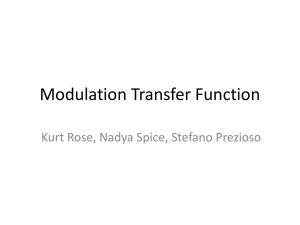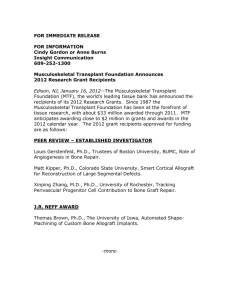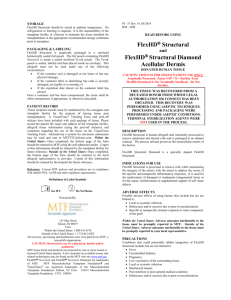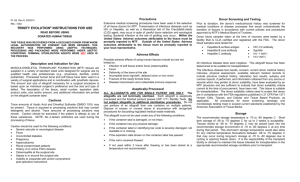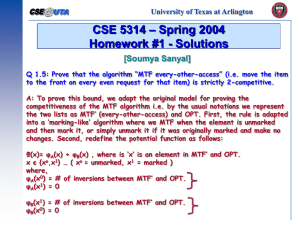7. O. Hadar, and A. Stern, “Image compression improvement by pre
advertisement
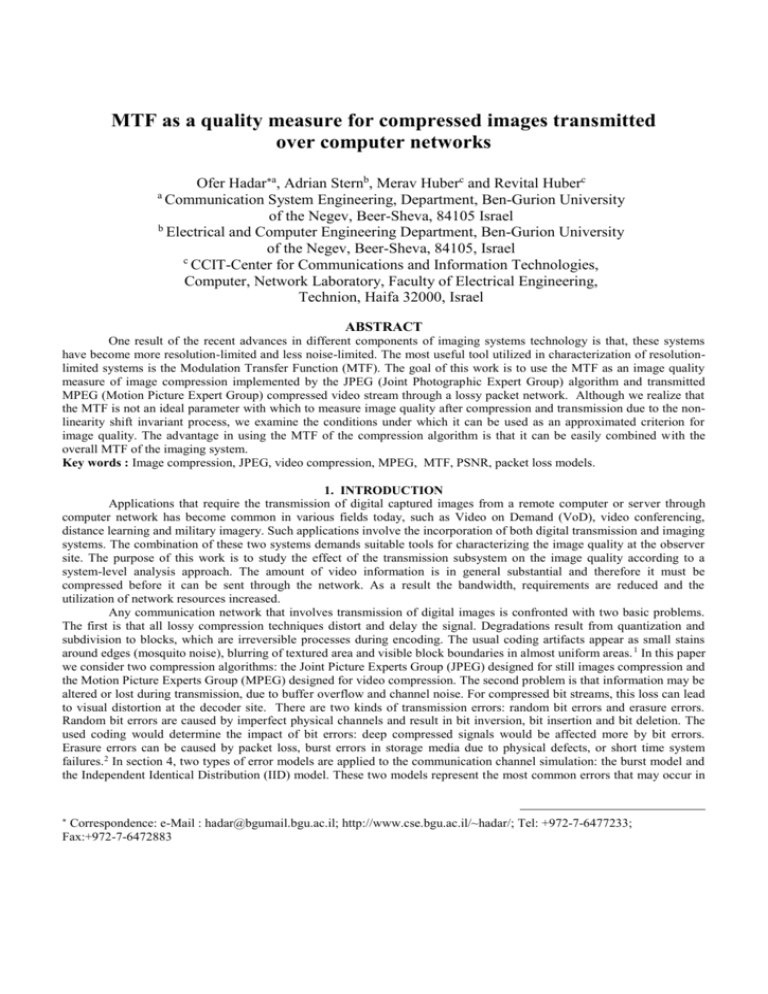
MTF as a quality measure for compressed images transmitted over computer networks Ofer Hadara, Adrian Sternb, Merav Huberc and Revital Huberc a Communication System Engineering, Department, Ben-Gurion University of the Negev, Beer-Sheva, 84105 Israel b Electrical and Computer Engineering Department, Ben-Gurion University of the Negev, Beer-Sheva, 84105, Israel c CCIT-Center for Communications and Information Technologies, Computer, Network Laboratory, Faculty of Electrical Engineering, Technion, Haifa 32000, Israel ABSTRACT One result of the recent advances in different components of imaging systems technology is that, these systems have become more resolution-limited and less noise-limited. The most useful tool utilized in characterization of resolutionlimited systems is the Modulation Transfer Function (MTF). The goal of this work is to use the MTF as an image quality measure of image compression implemented by the JPEG (Joint Photographic Expert Group) algorithm and transmitted MPEG (Motion Picture Expert Group) compressed video stream through a lossy packet network. Although we realize that the MTF is not an ideal parameter with which to measure image quality after compression and transmission due to the nonlinearity shift invariant process, we examine the conditions under which it can be used as an approximated criterion for image quality. The advantage in using the MTF of the compression algorithm is that it can be easily combined with the overall MTF of the imaging system. Key words : Image compression, JPEG, video compression, MPEG, MTF, PSNR, packet loss models. 1. INTRODUCTION Applications that require the transmission of digital captured images from a remote computer or server through computer network has become common in various fields today, such as Video on Demand (VoD), video conferencing, distance learning and military imagery. Such applications involve the incorporation of both digital transmission and imaging systems. The combination of these two systems demands suitable tools for characterizing the image quality at the observer site. The purpose of this work is to study the effect of the transmission subsystem on the image quality according to a system-level analysis approach. The amount of video information is in general substantial and therefore it must be compressed before it can be sent through the network. As a result the bandwidth, requirements are reduced and the utilization of network resources increased. Any communication network that involves transmission of digital images is confronted with two basic problems. The first is that all lossy compression techniques distort and delay the signal. Degradations result from quantization and subdivision to blocks, which are irreversible processes during encoding. The usual coding artifacts appear as small stains around edges (mosquito noise), blurring of textured area and visible block boundaries in almost uniform areas. 1 In this paper we consider two compression algorithms: the Joint Picture Experts Group (JPEG) designed for still images compression and the Motion Picture Experts Group (MPEG) designed for video compression. The second problem is that information may be altered or lost during transmission, due to buffer overflow and channel noise. For compressed bit streams, this loss can lead to visual distortion at the decoder site. There are two kinds of transmission errors: random bit errors and erasure errors. Random bit errors are caused by imperfect physical channels and result in bit inversion, bit insertion and bit deletion. The used coding would determine the impact of bit errors: deep compressed signals would be affected more by bit errors. Erasure errors can be caused by packet loss, burst errors in storage media due to physical defects, or short time system failures.2 In section 4, two types of error models are applied to the communication channel simulation: the burst model and the Independent Identical Distribution (IID) model. These two models represent the most common errors that may occur in Correspondence: e-Mail : hadar@bgumail.bgu.ac.il; http://www.cse.bgu.ac.il/~hadar/; Tel: +972-7-6477233; Fax:+972-7-6472883 a real communication network. The burst errors typically occur due to network congestion and the IID error model represents losses that may occur due to random noise in the channel. In this work, the transmission system is considered as a component of an overall imaging system that takes the image from the object plane to the observer. In system engineering approach it is important to determine final image quality or to design the system for a given required image quality. This requires quantitative criteria with which to define image quality. An engineering tool very appropriate for system design and analysis is the concept of the Modulation Transfer Function (MTF), which relates output and input to imaging system. Network transfer functions are an essential tool in electrical engineering. Similarly, Optical Transfer Functions (OTFs) are essential in image systems. 3 Imaging system is fabricated from many components, each of which can be characterized by its MTF. A block diagram for a typical imaging communication system is presented in Fig. 1. In order to be able to evaluate the overall system performance, each component should be described in the same manner. If each component in the system is described by its MTF then the overall system MTF is the product of the component MTFs. The objective of our work is to quantify the degradation obtained from compression and transmission over congested network and noisy channel. Eye Display Environment CCD Compression MTFsys = MTFenvironment · MTFoptics · MTFelectronics MTFeye Transmission · Decompression MTFcompression+transmission= ? · MTFdisplay · Fig. 1: Block diagram of imaging system incorporating compression and transmission . Today, most advanced imaging systems are resolution-limited rather than noise-limited, the common measure of degradation in resolution-limited systems is the MTF. A system level analysis of imaging systems includes compression and transmission requires the use of similar tools to characterize each component of the system. Compression algorithm performances are in general evaluated with measures appropriated to noise-limited systems, such as the Mean Square Error (MSE), and the Peak Signal to Noise Ratio (PSNR). These kinds of measures were appropriate for quantifying the image quality while systems were more affected by noise rather than by resolution. The paper is organized as follows. In Section 2 a short review on common image quality measures and their limitations are presented. Section 3 presents the influence of the JPEG still image compression algorithm. Section 4 presents the system simulation for transmission compressed digital video over noisy channels and Section 5 describes the results of image quality from the network simulation. Section 6 concludes the paper. 2. IMAGE QUALITY MEASURES AND THEIR LIMITATIONS As shown in Fig. 1, the compression algorithm can be understood as a component of the imaging system. Its contribution to image degradation could be described by the component MTF. This is the goal of the sensor designer/ analyst, however the MTF approach presents a number of problems. First the MTF of the component describes the spatial modulation throughput of the components, where the output frequency is some scaled value between 0 and 1 of the input frequency. The mathematical conditions for applying the Fourier transform to define the MTF include linearity and isoplanatism. In general optical imaging systems are not linear,4 however, they are approximated as Linear Shift Invariant (LSI) in order to use the powerful mathematical tools developed for LSI systems. Nonlinear components of an imaging system, such as imaging sensors, recording films, abberated optics, and so forth can be approximated as linear in a certain range, and the MTF is applicable in that specific range. For shift variant systems, such as imaging through turbid media, the average frequency response is calculated for isoplanatic patches. 5 Of course, the average performance of such an imaging system does not in general coincide with the actual performance. However, the average measure gives us an indication about the global performance of the system. Compression algorithms and the transmission process (Fig. 1) are not typically linear, which means that not all the spatial frequencies at the output image originate from the same spatial frequencies at the input image. The JPEG and the MPEG algorithms that are considered in this paper are not linear due to the use of the irreversible quantization matrix in the compression process. These algorithms are space variant (not isoplanatic) because the Discrete Cosine Transform (DCT) is applied on blocks. As a result, the MTF depends on the specific image contents to be compressed.6,7 When the same compression quality factor is applied on different images, different MTFs and compression ratios may be obtained. Therefore, the typical MTF cannot precisely describe the spatial frequency response of the compression algorithm. However, the average MTF can be used by considering the image complexity within a spatial frequency range. The measures most commonly used for quantifying the quality of compressed images are the Mean Square Error (MSE) and the Peak Signal to Noise Ratio (PSNR).8 They present the difference between the compressed image and the original image. As an example, for an image of size N x M pixels the MSE and the PSNR are given as, N M 1 MSE * [Original _ image(n, m) Degraded _ image(n, m)]2 M * N n 1 m 1 (1) 2 PSNR 10 log 10 ( P eMSE ) where P is the pixel's maximum value. The PSNR is a more appropriate measure because it is normalized to the intensity scale of the image. Never the less, is not an ideal measure for the following reasons: 1) it is more suitable for comparison purposes, and does not provide significant information about the absolute image; 2) unlike the MTF, it does not include information about the transform behavior at different spatial frequencies. 3) The human visibility factor is not taken into account in PSNR calculations. 4) The PSNR is a global measure and therefore does not give any local information about the output image quality. It may occur that two images have the same PSNR value, but that the information loss is different (Fig. 2). Fig. 2 : Two kinds of distortion with same PSNR [Ref. 9 ] Cox and Driggers6 proposed an Information Transfer Function (ITF) that can be used in a similar manner as the MTF. This measure describes the correlation between the input image and the output image as a function of the spatial frequency compression ratio and the image complexity. They suggest two types of ITF’s. The first is defined as the ratio of the crosscorrelation between the original image and the compressed image and the autocorrelation of the original image calculated at different spatial frequencies. The crosscorrelation and the autocorrelation functions are derived at zero spatial displacement, so there is a hidden assumption of stationarity. The ITF defined this way is related to the MTF; actually it can be easily shown that for stationary images the ITF is identical to the MTF. The second ITF measure is defined as 1-MSE, which is calculated separately for each spatial frequency. 3. THE MTF OF JPEG COMPRESSED IMAGES In this section, we investigate the behavior of the compression MTF with different test images and several compression ratios, for which images were compressed and reconstructed with a JPEG compression algorithm. The JPEG standard 8 is a collaborative effort of the CCITT (International Telegraph and Telephone Consultative Committee) and the ISO (b) (a) Fig. 3 (a) “sun” and (b) “trees” test images. (International Standards Organization), and actually comprises a variety of methods. We applied the implementation most widely- used to separate the image into 8X8 blocks, perform two-dimensional (2D) DCT on each block, and quantize the DCT coefficients with respect to a quantization matrix specified by the “q” quality factor. The 2D DCT coefficients are then converted to a 1D matrix using a zig-zag scan. This 1D matrix is coded using predefined Huffman coding tables. The remaining 1D data stream includes many zero coefficients that represent high spatial frequencies, which are coded by a run length code. The decompression or image reconstruction procedure reverses the compression steps. We used five test images: a point target, a line target, an edge target, a “sun” target and a “trees” image. The point target is a white pixel in the center of a 512X512 image with a black background. The line target is a similarly-sized image with a horizontal white line in the middle. The edge target is a half-white (512x256 pixels) half-black image. The “sun” target and the “trees” image are shown in Fig. 3. The “sun” is a circular sinusoidal image with an angular frequency of 1/20 cyc./rad. The decompressed point and line test images can be considered as a Point Spread Function (PSF) and a Line Spread Function (LSF), respectively. The Fourier Transforms (FT) of these images yield the Optical Transfer Function (OTF), and the absolute value of the OTF gives the MTF. The MTF obtained this way is accurate only for LSI transform. However, since the JPEG algorithm is not LSI, the MTF is only an approximation of the transform frequency response. The MTF calculated this way depends on the position of the point or the line. Shifting the point and line in the test images to different locations yield different MTFs as demonstrated in Fig. 4 showing eight MTFs (dashed lines) appropriate to eight lines in the center of the image. These MTFs represent all possible MTFs of horizontal test images. The solid line in Fig. 4 shows the average MTF in the horizontal direction for the line test image. As mentioned earlier the use of the average MTF is common for other space variant systems as mentioned before. The average MTF does not specify local quality of the decompressed image, but gives an indication about the global decompressed image quality. Fig. 4 Dashed lines - Estimated MTFs for line test images with the line placed at different locations; solid line – average MTF. The LSF is estimated from the decompressed edge target by deviating the image in the edge direction.3 The average 1D MTF is estimated by taking the absolute value of the LSF Fourier transform and averaging the pixels in the direction normal to the edge. The edge test image is used to estimate the non-linearity effect of the compression on the LSF because the edge target can be viewed as combination of line targets. We designed the “sun” target [Fig, 3(a)] because it is isotropic and has spatial frequencies in a continuous range. The intensity (image irradiance values) on each arc between two lines changes sinusoidally with a spatial frequency depending on the distance from the origin: f where 20r (2) f is the spatial frequency in polar direction and r is the circle radius (distance from the origin). Our “sun” target is related to commonly - used targets such as the “sector star target” and the “RCA” target, but also differs from them in that its intensity is sinusoidal on a given arc rather than having a square–wave form. For each arc, we calculate the Modulation Contrast3,4 (MC) defined as (Imax -Imin)/ (Imax+Imin), where Imax and Imin are the maximum and minimum intensity values on the arc respectively. By dividing the MC of the decompressed image to the MC of the original image and by using Eq. 2 we find the Modulation Contrast Function (MCF) for the spatial frequency related to the radius of the arc. For LSI transforms of sinusoidal targets (such as the “sun” target) the MCF is identical to the MTF. We calculate the average MCF for each spatial frequency by averaging the MCFs obtained for all possible arches with the same radius, which is related to the spatial frequency according Eq. 2. Fig. 4 shows this average MCF for three quantization factors (quality factors) q=50, 10 and 0 yielding compression ratios (=original image size/compressed image size) of 9, 18 and 32 respectively. Fig. 5: Average MTF derived from the “sun” target from 3 different quantization matrixes As expected, it can be seen that the MTF is lower for deeper compression (higher compression ratios). However, the MTF for all three cases does not decrease significantly, and the lowest value (up to spatial frequency of 0.35 cyc./pixel) is 0.75. This observation indicates that the JPEG algorithm does not seriously affect the image contrast. We can be observe this visually in Fig. 6 (b) which shows the “sun” image after compression with the lowest quality factor (highest compression ratio) and decompression. In each ray the minimum and maximum intensity values (black and white) determining the MC remain approximately similar to that of the original image. Even in the central area of the image containing high spatial frequency components, the rays are resolvable approximately as they are in the original image [Fig. 6(a)]. Thus, for JPEG compression, the average MTF is related to the average ability to resolve objects. However, the MTF does not indicate the distortion that is apparent even at low frequencies (large distances from the center). This distortion is mainly due to blocking effects8,7 and artifacts resulting from Gibb’s phenomenon. 8 From the perspective of the Fourier domain, the JPEG algorithm only slightly affects the fundamental spatial frequency of a periodical image. Therefore, the contrast appears almost unaffected. However, since JPEG is not an LSI transform, it adds spatial frequency components, which cause the visible distortions. These distortions can be quantified by using the PSNR measure or the 1-MSE measure defined above.6 Unfortunately, for non-LSI transforms, the MSE based measures are image dependent and, therefore, can be characterized only for a specific group of images. (a) (b) Fig. 6 (a) original “sun” image, (b) “sun” image after compression with quality factor q=0. Note that the rays are almost resolvable as in (a). The “trees” image [Fig. 3(b)] was chosen to analyze the JPEG MTF for a non-artificial image. The MTF is calculated via the power spectrum density (PSD) of the images 10: MTF ( f ) S IO ( f ) S OO ( f ) (3) where SIO(f) is the cross PSD of the decompressed and original image and SOO(f) is the original image PSD. The PSD is estimated using Welsh method with overlapping blocks and a Hanning filter. 10 For LSI transforms of the original images, S IO ( f ) . For JPEG transform Eq. 3, is considered as an approximation of the S OO ( f ) the MTF can be described precisely by mean MTF. In Fig. 7 the average MTF calculated from the “trees” image is shown together with the average MTF for the other four tested images. It can be seen that the MTF depends on target complexity. The more complex the image, the higher is the MTF. In order to characterize the image complexity, we divide the image into N 16X16 blocks and calculate the standard deviation of each block. The complexity is given by: 1/ 2 1 N complexity i2 N i 1 . (4) A similar approach is used to measure the clutter. 11 The size of the block dimension for the clutter measure is taken as twice the target size. The lowest complexity using (4) is obtained for the point target and equals 1 and the highest is obtained for the test image and equal 33. Fig. 7 : MTF derivation for JPEG image compression from different objects. 4. MTF FOR TRANSMITTING-MPEG COMPRESSED IMAGES In this section an imaging system with a compression and transmitting sub-block is considered (Fig. 1). The compression-transmission scenario is illustrated in Fig. 8 where the server transmits the video stream through the channel toward the client. The original analog signal is compressed by the MPEG algorithm. Then it is transmitted through a noisy channel where packets may be lost. The received signal by the client is decompressed and transformed to an analog signal by the MPEG player. The MPEG standard was developed by the ISO/IEC JTC1/SC29 WG11, working group within the International Standards Organization, for compressing motion pictures and multimedia, in contrast to JPEG, which is used for still images. There are three types of pictures that are considered in MPEG: Intra pictures (I-frames), predicted pictures (PFrames) and bi-directional (interpolated) pictures (B-Frames). The I-Frame is the first frame of each GOP. The intra pictures (I-Frames), provide reference points for random access and are subjected to moderate compression. From the compression point of view, I-pictures are equivalent to images and can be DCT encoded using a JPEG-like algorithm. In P and B pictures, the motion-compensated prediction errors are DCT coded. Only forward prediction is used in the P-pictures, which are always encoded relative to the preceding I- or P- pictures. The prediction of the B- pictures can be forward, backward, or bi-directional relative to other I- or P-pictures. In addition to these three, there is fourth type of picture called D-pictures, containing only the DC component of each block. They are mainly useful in browsing at very low bit-rates. The number of I, P, and B frames in a GOP is application dependent. For example, it depends on the access time requirement and the bit-rate requirement.12 Server Client Analog video Analog video Encoder Decoder Lossy packet network Transmitter Original video stream Receiver Received video stream Fig. 8 A video stream transmitted through the network In order to measure the MTF from an MPEG video stream we created a special sequence of images that is suitable for deriving the MTF in all directions. The sequence includes images of a spreading and shrinking white disk over a black background. The radius of the circle changes at a rate of one pixel in each frame where there are 25 frames per second. The isotropic symmetry of the images allows us to derive the MTF at three representative angles horizontal (0o), vertical (90o), and diagonal (45o). After creating the sequence from a collection of separate frames it was compressed by the MPEG encoder. Periodically the compressed video stream was transmitted through the simulated lossy channel several times in order to acquire sufficient data, reaching a total stream of 1200 frames. The stream was divided into blocks of equal size, each block containing 64 bytes. A model-based data loss generator was used to simulate packet network losses, which included the burst and the IID models. In the IID model, we draw a random number, uniformly distributed between 0 and 1. If the drawn number is higher than a certain Packet Loss Ratio (PLR) value, the packet is considered as correctly accepted. Otherwise, the packet is considered as lost. The PLR value is a pre-determined parameter in the simulation; we use three values of PLR: 0.01, 0.02 and 0.04. In the burst model, we draw two random numbers. The first number determines whether there will be a packet loss, and the second determines the number of packets that will get lost all together. The burst size is randomly selected between 1 and 10. The total error probability is the same as in the IID model. The losses occur randomly, such that any packet may be lost, independent of the importance of the information type. The degradation of quality depends on the picture type of the lost video data because of the predictions used for MPEG. For example, if loss occurs in a reference picture (I or P picture), the lost macroblocks will affect the predicted macroblocks in subsequent frames. This is known as temporal propagation.1 The analysis of the image quality after decoding is applied separately to each image from the sequence according to the same method described in the previous section for JPEG compression. In this work, we assume that there is no use of an algorithm for concealment of missing packets. Therefore, any lost packet may reduce the quality of the video stream. Video quality is evaluated by the MTF and the PSNR tools presented earlier. These measures are calculated at the output decoded video stream (Fig. 1), where the compression and transmission subsystems are considered as one unit. The results of the MTF for PLR=0.01 are presented in Figs 9 and 10 for the IID and the burst loss models respectively. Fig. 9 Average MTF curves, for IID loss model and PLR=0.01, for three angles: (a) 0 (b) 90 (c) 45. Fig. 10 Average MTF curves, for burst loss model and PLR=0.01, for three angles: (a) 0 (b) 90 (c) 45. Each figure includes three separate graphs, for the three angles: 0˚, 90˚, and 45˚. The MTF curve represents the average MTF of the whole sequence. It is measured from the edge response along the three angles by using the Fourier transform of the derivative of the edge response. The MTF is a measure of the edge sharpness. Therefore, only frames which exhibit a blurring effect and not other kinds of degradation, were considered in the MTF derivation. As a result, we applied an algorithm to select the appropriate frames from the whole sequence. Only MTF vectors whose zero spatial frequency component was equal to one (MTF(f=0)=1) were taken into account. The percentage of frames participating in the average MTF calculation was lower than 25 %, for all the sequences tested. For example, in the IID loss model, at 0˚, and PLR=0.01, 16.5% of the frames were included, while for the burst loss model 20.416%. The results at 0˚ for PLR=0.02 were: IID loss model 12.87% and burst 18.88%, while for PLR=0.04, IID was 10.583% and burst 13.083%. These results show that most of the degradation resulting from compression combined with packet loss cannot be measured by MTF but by other quality measures. From the simulations it appears that the number of frames participating in the average MTF derivation decreases as the packet loss probability increases, and it is always higher for the burst loss model. Similar results were obtained also for the other two angles of 45˚ and 90˚. As the PLR decreases, the MTF measure represents more degraded frames, and the obtained average MTF is more reliable. In general it would seen that the MTF is a more accurate measure for low packet loss probability. By comparing the MTF acquired for the burst model to that acquired from the IID model, it can be observed that smoother curves are obtained in the burst model. The reason is that more frames participate on deriving the average MTF in the burst model than in the IID model. For all the simulations, the reduction as function of the spatial frequency of the modulation contrast is not significant. The maximum reduction with the MTF is 35% at the highest normalized spatial frequency (0.5 cycles/pixel) for 90˚, for burst loss model with PLR=0.04. In general, all the MTF curves behave similarly and it is quite difficult to distinguish between the burst model and the IID model. By comparing the MTF at the three angles, the greatest degradation occurred at the horizontal (0˚) direction. This can be observed from the low number of frames participating in the average MTF. This can also be observed by viewing the video streams with the MPEG decoder. The video quality in the horizontal direction suffers from degradation effects which are more severe than smearing, such as block misplacing, block missing, and temporal propagation of errors. The explanation for this result is that the number of pixels in the 0˚ direction is 80 compared to the other two directions, where the number of pixels is 60. Thus, the probability of packet loss in the horizontal direction is higher. For an additional comparison between the two loss models, we use the PSNR measurement calculated according to Eq.(1). Here, the PSNR quantifies only the effects of the lossy network on the video streams. In Figs 11 and 12, the PSNR histograms are presented for PLR equal to 0.01 and 0.04, respectively. Each figure contains two graphs: (a) the burst loss model, and (b) the IID model. The histograms represent the total number of frames that have PSNR values in a certain range (bin). The isolated right bin represents the number of undistorted received frames, which have theoretically infinite PSNR (zero MSE) compared to the respectively transmitted frames. (a) (b) (b) (a) 11 PSNR histograms for PLR=0.01. (a) Burst loss model (b) IID loss model. Fig. Fig. 12 PSNR histograms for PLR 0.04. (a) Burst loss model (b) IID loss model Table 1 summaries the results of the average PSNR, the variance PSNR, and the number of identical frames. Table 1 : Summarized statistics of the PSNR Packet Loss Probability : 0.01 0.02 0.04 81.0545 67.2887 68.6210 IID: average 1.2538e+03 400.7862 282.8412 Variance 90 24 19 Number of identical frames 128.1374 103.8463 92.1583 Burst: average 3.5010e+03 2.9371e+03 2.2896e+03 Variance 480 243 173 Number of identical frames Fig. 12 PSNR histograms for PLR 0.01. (a) Burst loss model (b) IID loss model. These results show that the average PSNR calculated from a video stream degraded by burst losses is much higher than one degraded by IID losses. This can be explained by the fact that a larger part in a single frame is destroyed by burst, unlike IID, where many small parts of different frames are degraded. Note that the packets after an important header is lost are useless. Therefore, in the case of the burst losses where packets are lost in groups, packets that may be lost after header packet will not actually effect the video stream. On the other hand, for the IID model, losses are randomly distributed. Therefore each packet has the potential to affect the received video stream. It is evident from the results of Table 1 and Figs 11 and 12 that the number of undistorted frames is much larger in the burst model than in the IID model. The difference is very noticeable, despite the use of the same loss-probability in both cases. As expected, as the PLR increases the average PSNR decreases, and the number of undistorted frames decreases. 5. CONCLUSIONS In this work we evaluated the average MTF obtained from a compressed image transmitted through a lossy computer network. First, we evaluated the distortion of JPEG compressed images in terms of the MTF. We showed that the average MTF represents the reduction with contrast as a function of spatial frequency, which is not the main cause for the image distortion. This was an expected result, since nonlinear and space variant transformations cannot be precisely evaluated by using frequency response measures. In the second part of the paper we analyzed the influence of packet losses and video compression on the quality of the received video stream. We demonstrated that the burst loss model has a less severe impact on the video stream as compared to the IID loss model. We found that the average MTF is a more accurate measure for low packet loss ratios. As the number of lost packets increases there are additional distortions that cannot be evaluated by the MTF, indicating more measures have to be developed. As we mentioned, since packet loss and compression are not linear space and time invariant transformations, spatial frequency response measures can only partially represent the distortion process. 6. ACKNOWLEDGMENTS We would like to thank Doron Fuchs, and Hanan Dagan for their help in coding the simulation software, and to the Computer network laboratory Faculty of Electrical Engineering in the Technion. 7. REFERENCES 1. 2. 3. 4. 5. 6. O. Verscheure, X. Garcia, G. Karlsson and J.P. Hubaux, “User-Oriented QoS in Packet Video Delivery”, in Proc. IEEE network, November/December 1998. Y. Wang and Q.F. Zhu, “Error Control and Concealment for Video Communication: A Review”, in Proc. IEEE, vol. 86, No. 5, May 1998. N. S. Kopeika, A System Engineering Approach to Imaging, chap. 9, pp. 517-524, SPIE Optical Engineering Press, Bellingham WA, 1998. H. C. Holst, Electro-Optical Imaging System Performance, SPIE optical engineering press, Washington, 1995. K. W. Goodman, Statistical Optics, John Wiley, New York, 1985. P.G. Cox and R.G. Driggers, “Information Transfer Function for Image Compression Algorithm”, in Proc. of SPIE, vol. 3063, pp. 23-30, 1998. O. Hadar, and A. Stern, “Image compression improvement by pre-filtering”, in Proc. of SPIE, Vol. 3460, pp. 895-905, Applications of Digital Image Processing XXI, A.G. Tescher; Ed. San-Diego, CA, USA, 1998. 8. J.C. Russ, The Image Processing Handbook, 2nd ed. IEEE Press, Boca Raton, Florida, 1994. 9. http://cj.msu.edu/~jones/research/clemen41/psnr.html 10. R. Shiavi, Introduction to Applied Statistical Signal Analysis, Irwin and Asken Associates, Inc., Boston , 1991. 11. O. Hadar, A. Mendelblat, R. Sabat, N. S. Kopeika and S. R. Rotman, "Influence of sensor motion on target acquisition," Infrared Physics and Technology, vol. 38, pp.373-382, June 1997. 12. S. V. Raghavan, and S. K. Tripathi, Networked Multimedia Systems: Concepts, Architecture, and design. Prentice Hall, 1998. 7. 1 2 Y. Wang and Q.F. Zhu - Error Control and Concealment for Video Communication: A Review. - proceedings of the IEEE, vol. 86, No. 5, May 1998. 3N. S. Kopeika, A System Engineering Approach to Imaging, chap. 9, pp. 517-524, SPIE Optical Engineering Press, Bellingham WA,1998. Holst H. C., Electro-optical imaging system performance, SPIE optical engineering press, Washington, (1995). 4 Goodman K. W. (1985) Statistical optics. John Wiley, New York. 5 P.G. Cox and R.G. Driggers - Information Transfer Function for Image Compression Algorithm. Proc. 6 of SPIE vol. 3063, p. 23-30. O. Hadar, and A. Stern, “Image compression improvement by pre-filtering,” in 7 Proc. SPIE Vol. 3460, p. 895-905, Applications of Digital Image Processing XXI, Andrew G. Tescher; Ed, 8Russ J. C. (1994) The image processing handbook. 2nd ed. IEEE Press, Boca Raton, Florida. http://cj.msu.edu/~jones/research/clemen41/psnr.html 9 10. R. Shiavi, Introduction to Applied Statistical Signal Analysis, Irwin and Asken Associates, Inc. ,Boston, 1991. 11. המאמר של עופר בinfrared phisics S. V. Raghavan, and S. K. Tripathi, Networked Multimedia Systems : Concepts, Architecture, and design. Prentice Hall, 1998. 12
